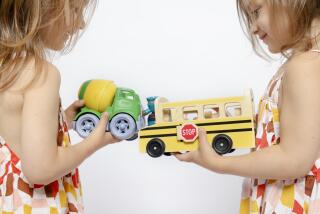THE GOODS : ECONOTES : New Game Is Tree-Friendly in a Couple of Ways
Toby Zellers is a newcomer to the multibillion-dollar family-game industry, but he’s trying to make an environmental ripple and sell some games at the same time.
His Seven Wonders Game Co. Inc., based in Englewood, Colo., has introduced the first game in what he envisions as a “Better Products for a Better World” series.
What’s the gimmick? Not only are the games produced from 100% environmentally sound material, such as recycled paper and soy ink, he says, each game will benefit an environmental cause.
His first game, just released, is Prism Quest, a fantasy game employing dice, code books, code pads and more than 150 playing cards. For every game sold ($24.95, plus $4 shipping and handling, if ordered from the company), Seven Wonders will donate $1 to the National Arbor Day Foundation, to plant a tree in Yellowstone National Forest, Zellers said.
“Even recycled paper takes trees,” he said. “We can’t just keep chopping down these trees. This way, we are putting something back.”
Zellers, 30, has been in the printing business all his life and the new game company is a division of his AccuGraphics Inc. He wants to encourage game manufacturers to follow his example.
“Some manufacturers do use recycled paper,” he said, “but most people still don’t realize it can be colorful and beautiful. Our game is printed on mostly glossy and coated stocks. We want people to know the techniques have improved.”
His next game, Sphinx & Pharos, will be based on ancient Egyptian culture. Who will be the beneficiary?
“We’re torn between an organization like Greenpeace or a project to save the pyramids,” Zellers said. “They’re falling apart right now.” Information: (800) 783-9631.
*
Readin’, Writin’ and Recyclin’: That’s the curriculum trend in the nation’s schools, a new survey says. Virtually every school in the country now has some kind of environmental education program, according to Environmental Research Associates (ERA), which studies environmental attitudes and their effect on consumer behavior.
ERA staffers interviewed a nationwide sampling of 279 teachers, principals and school administrators. Compared to the same study in 1992, they found that student participation in school-based activities has shot up in many categories.
“While we found environmental classes at all levels, they are particularly increasing in elementary schools--up to 61% in 1994 from 43% in 1992,” said Anthony M. Casale, president of ERA, based in Princeton, N.J.
Students are also taking more field trips to recycling facilities, nature centers and marine conservatories. Although books and magazines are the leading sources of environmental education, computer programs and games are closing the gap.
*
With more than 5 million public school students in California, waste from school lunches alone could total more than 15 million throwaways daily, says the California Integrated Waste Management Board.
More to Read
The biggest entertainment stories
Get our big stories about Hollywood, film, television, music, arts, culture and more right in your inbox as soon as they publish.
You may occasionally receive promotional content from the Los Angeles Times.










